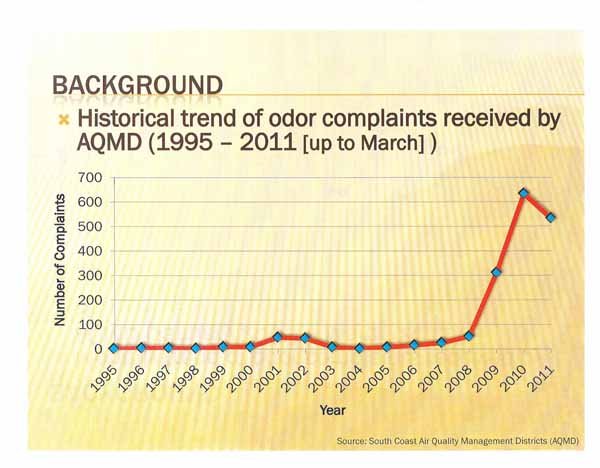From https://www.latimes.com/news/local/la-me-adv-stink-squad-20120211,0,6480031.story
In the face of numerous complaints and violations, Sunshine Canyon Landfill has organized an ‘odor patrol team’ to sniff out olfactory offenses in the Granada Hills North neighborhood. But its efforts haven’t always passed residents’ smell test.
Dennis Montano stood on a corner in Granada Hills one recent brisk morning, lifted his nose to the sky and sniffed.
“Right now, I don’t smell anything,” Montano said.
That was good news for the embattled Sunshine Canyon Landfill. The disposal site operates roughly a mile away in Sylmar but has roiled the Granada Hills North neighborhood with a potpourri of foul smells. In the face of numerous complaints and dozens of public nuisance violations, the company has organized an “odor patrol team” in an effort to improve community relations and comply with state regulations.
As a member of the company’s team, the 32-year-old Montano has found himself on the front line of a pungent conflict. Sunshine operators insist that odor patrols will help fan the quality of life downwind, but some residents charge that they are simply for show and accomplish nothing.
“As far as neighbors are concerned, it’s a sham,” said Wayde Hunter, president of North Valley Coalition of Concerned Citizens Inc., a nonprofit group that has been fighting the dump for more than two decades. “They have zero credibility in the neighborhood. If you ask anyone in the community about the team, they’ll tell you that what they’re doing is basically B.S.”
Formally launched in 2010, the patrols are intended to head off complaints by detecting problem odors early.
If an odor is sensed, the monitor notifies site staff who conduct an on-site odor survey to determine the source and identify what immediate steps can be taken to mitigate it. They check the environmental control systems for any disruptions, and sometimes contractors are called in to make temporary fixes ahead of permanent repairs, operators say.
“We want to be good neighbors,” said Patti Costa, environmental manager for the landfill, which is operated by Republic Services Inc. a Phoenix-based solid waste collection and disposal company. “We want to solve this issue. We don’t take it lightly.”
Working five-hour shifts that typically begin at 5:30 a.m. or 5:30 p.m. and cover between five and 10 miles, Montano stops at 13 locations in the Granada Hills North neighborhood.
His first location for gauging odors is in front of Van Gogh Elementary School. He uses an anemometer to determine altitude, latitude, longitude, relative humidity and the direction and speed of the wind.
On this particular morning, the wind was blowing from the north at 3.3 mph, the temperature was 55.5 degrees Fahrenheit and the relative humidity was 23.6%.
Montano entered the information into an iPad before again taking a whiff. He then employed a “Nasal Ranger,” a portable odor detection and measuring device that resembles a bullhorn. Pressing the instrument to his nose, he inhaled a few times and twisted a dial at the end of the device, which is embedded with carbon filters. The higher the number on the dial, the more distinct the odor, Costa explained.
Montano, who used to work in inventory control for the Academy of Motion Picture Arts and Sciences, said he applied for the odor management team job after being tipped off by a friend. He took the prerequisite “sniff test,” formally known as an Odor Sensitivity Test Kit, and passed with flying colors, Costa confirmed.
“I actually didn’t know about my nose until I interviewed and took the test,” Montano said.
But Montano isn’t the only one with a keen sense of smell.
In 2011, 1,565 odor complaints against Sunshine Canyon were lodged with the South Coast Air Quality Management District, up from 613 the year before and 310 in 2009, according to state statistics. Last year’s figure represented around 20% of all air quality complaints the agency received from operations under its jurisdiction. So far this year, at least 182 complaints have been made against the landfill, which disposes of up to 10,000 tons of trash per day on 363 acres.
The smells were primarily from rotting garbage or landfill gas — “a sickly sweet type of odor” — said Sam Atwood, a spokesman for the air quality management agency.
To comply with an abatement order issued in 2010 and most recently amended in December, the landfill is taking several actions before a February deadline. Among them: instituting a robust gas collection and destruction system, including installing a temporary gas flare to destroy excess landfill gas; conducting a 12-month study to analyze potential air toxins; hiring an independent consultant to do environmental monitoring and take corrective action; and designating staff to be on call 24 hours a day to investigate and, where feasible, immediately remediate the source of odors.
The company is also taking other mitigation steps, such as installing “dust bosses” that spray a fine mist into the air to trap odor particles before they can disperse, and planting scores of oak trees to help block smells, Costa said. She urged residents to utilize a 24-hour complaints hotline.
Though the landfill operator was taking odor complaints seriously, Costa said it was possible some of the scents were caused by other non-landfill sources, such as skunks, fertilizers and sewers.
But resident Ralph Kroy scoffed at that notion. Kroy, whose house sits across from Van Gogh Elementary, said he had no doubt where the stink was coming from.
“It’s a darn nuisance,” said Kroy, who has lived in the neighborhood since 1968 and lodged dozens of odor complaints over the years. “You go outside … and oh my gosh.”
Nor was he impressed by the new odor patrols.
“They can’t collect anything,” Kroy said. “The smell is still there.”
 Wikimedia Commons Bill Gates’ Cascade Investment LLC now owns more than 24% of Republic Services outstanding stock.
Wikimedia Commons Bill Gates’ Cascade Investment LLC now owns more than 24% of Republic Services outstanding stock.
